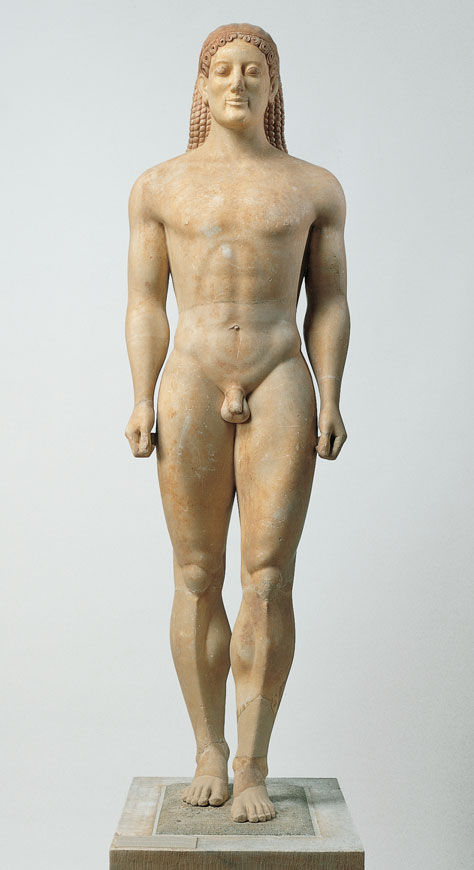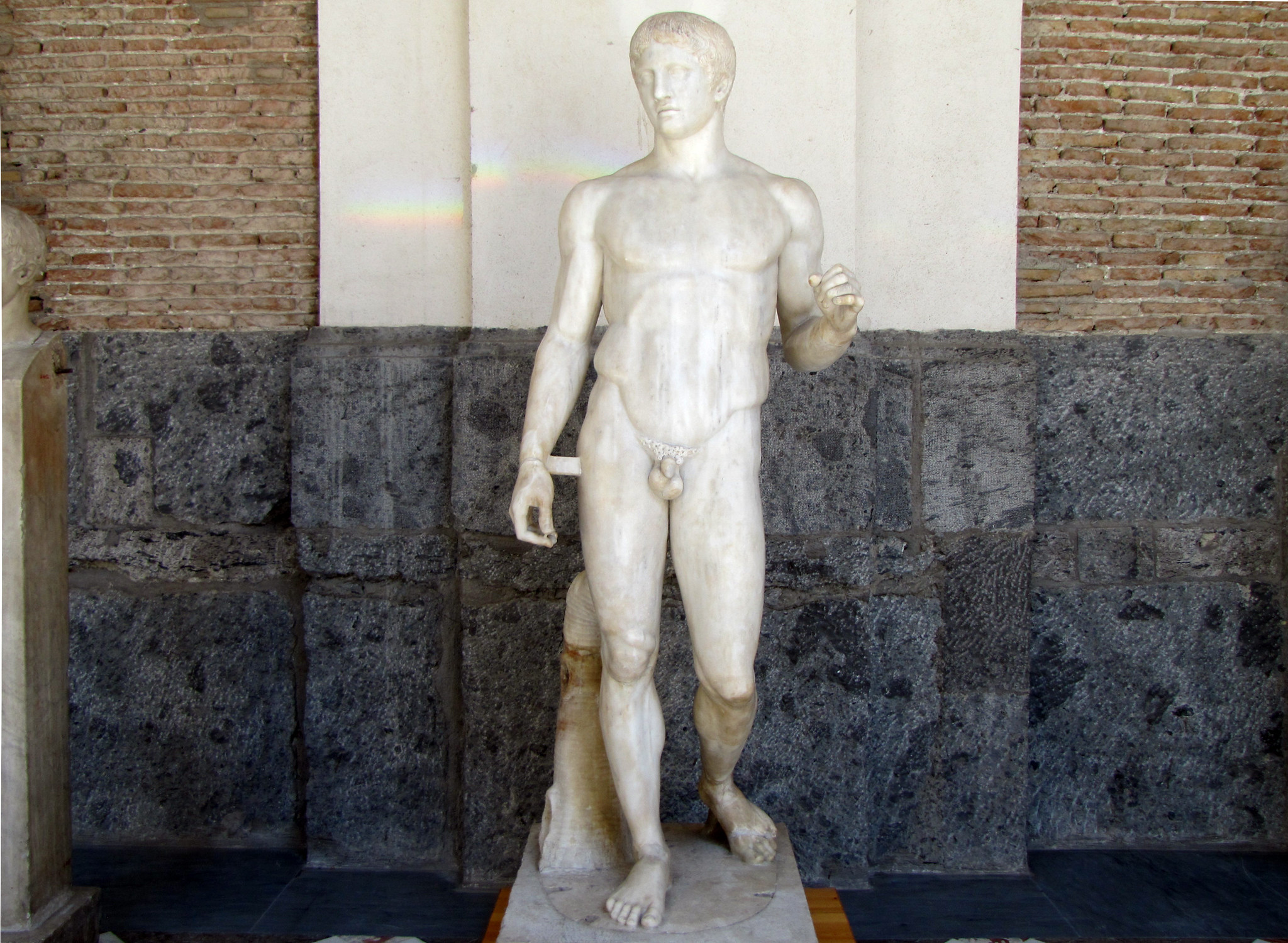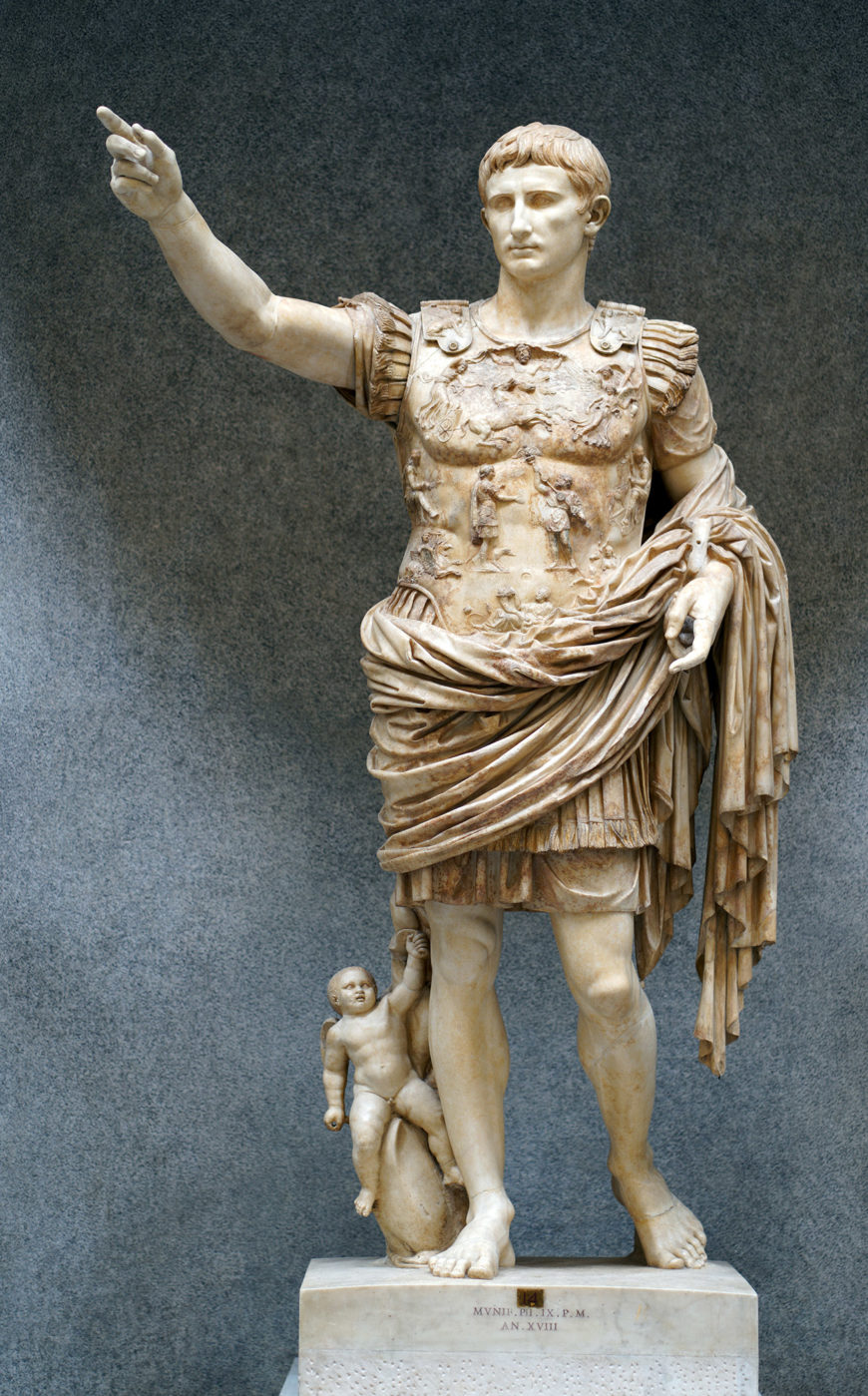2.2 Interactions Across Cultures in Ancient Mediterranean Art
4 min read•june 18, 2024
AP Art History 🖼
34 resourcesSee Units
From the mysterious and powerful Anavysos Kouros, to the masterful representation of the human form in the Doryphoros (Spear Bearer), to the grandeur and political propaganda of the Augustus of Prima Porta, to the Colosseum as a symbol of power, engineering and entertainment. This study guide is a unique opportunity to study the intricacies of these ancient artworks and understand the cultural interactions that influenced their creation.
Anavysos Kouros (530 BC)

Anavysos Kouros, c. 530 B.C.E., marble, 6' 4" (National Archaeological Museum, Athens)
- Anavysos Kouros is a marble statue from ancient Greece that depicts a young, naked male figure.
- The statue is believed to be a representation of a kouros, a specific type of statue that was popular in ancient Greece during the Archaic period. Kouros statues typically depict young men and were used as grave markers or as dedicatory offerings to the gods.
- The Anavysos Kouros is notable for its realistic and detailed musculature, which was achieved through the use of incised lines to create the illusion of depth.
- The statue is also notable for its facial expression, which appears to be contemplative and introspective. This is in contrast to the more common "archaic smile" that is seen on many kouros statues.
- The Anavysos Kouros is considered to be one of the best examples of Archaic Greek sculpture and is an important work in the study of ancient Greek art.
Doryphoros (Spear Bearer) (440-430 BC)

Polykleitos, Doryphoros (Spear-Bearer) or Canon, Roman marble copy of a Greek bronze, c. 450–440 BCE (Museo Archaeologico Nazionale, Naples; photo: Steven Zucker, CC BY-NC-SA 2.0)
- Doryphoros is a marble statue from ancient Greece that depicts a young, athletic male figure.
- The statue is believed to be a representation of a hoplite, a type of heavily armed infantryman who fought in the phalanx formation.
- The statue is notable for its lifelike portrayal of the human form, particularly the musculature and movement of the body.
- The statue is also notable for its contrapposto stance, in which the weight of the body is shifted to one leg, creating a sense of movement and dynamic tension.
- The Doryphoros is considered to be one of the greatest examples of classical Greek sculpture and is an important work in the study of ancient Greek art.
Augustus of Prima Porta (20 BC)

Augustus of Primaporta, 1st century C.E., marble, 2.03 meters high (Vatican Museums) (photo: Steven Zucker, CC BY-NC-SA 2.0)
- Augustus of Prima Porta is a marble statue of the Roman emperor Augustus.
- The statue is notable for its lifelike portrayal of the emperor, including his facial features and clothing.
- The statue is also notable for its idealized portrayal of the emperor, depicting him as a strong and powerful leader.
- The statue is also notable for the inscription on the base of the statue, which reads "To the invincible god Augustus, son of a god, pontifex maximus, from the Senate and people of Rome". This inscription emphasizes Augustus' divine status and the support he received from the Roman people.
- The Augustus of Prima Porta is an important work in the study of Roman art, particularly the art of the Imperial period.
Colosseum (70-80 AD)

Colosseum (Flavian Amphitheater, or Amphitheatrum Flavium), c. 70-80 C.E., Rome,
- The Colosseum is an oval amphitheater in Rome, Italy, built during the Flavian dynasty.
- The Colosseum is the largest amphitheater in the world and could seat up to 50,000 spectators.
- The Colosseum was used for a variety of entertainment events, including gladiatorial contests, animal hunts, and mock naval battles.
- The Colosseum is notable for its architectural design, which includes 80 arched entranceways, four levels of seating, and an underground network of tunnels and chambers.
- The Colosseum is an important work in the study of Roman art, particularly the art of the Imperial period, and is an iconic symbol of Roman civilization.
- Architects used geometry 📐 when constructing their buildings.
In conclusion, the study of Interactions Across Cultures in Ancient Mediterranean Art has provided insight into the diverse artistic conventions of the ancient Mediterranean world. We have seen how the Anavysos Kouros sculpture, for example, is an example of the Archaic Greek style of art, characterized by its frontal pose and the use of the contrapposto stance. The Doryphoros (Spear Bearer) by Polykleitos, on the other hand, exemplified the Classical Greek style, characterized by its realism and idealization of the human form. The Augustus of Prima Porta, created under the Roman Empire, showcases the Roman's skill in portraiture and propagandistic art. Finally, the Colosseum, is an example of the engineering and architectural skills of the Romans, and how it was used for both entertainment and political purposes. This study guide highlights the complexity and richness of the ancient Mediterranean art and culture, and how it has shaped the world we live in today.
Browse Study Guides By Unit
🗿Unit 1 – Global Prehistoric Art, 30,000-500 BCE
🏛Unit 2 – Ancient Mediterranean Art, 3500-300 BCE
⛪️Unit 3 – Early European and Colonial American Art, 200-1750 CE
⚔️Unit 4 – Later European and American Art, 1750-1980 CE
🌽Unit 5 – Indigenous American Art, 1000 BCE-1980 CE
⚱️Unit 6 – African Art, 1100-1980 CE
🕌Unit 7 – West and Central Asian Art, 500 BCE-1980 CE
🛕Unit 8 – South, East, and Southeast Asian Art, 300 BCE-1980 CE
🐚Unit 9: The Pacific, 700–1980 ce
🏢Unit 10 – Global Contemporary Art, 1980 CE to Present
📚Study Tools

Fiveable
Resources
© 2025 Fiveable Inc. All rights reserved.